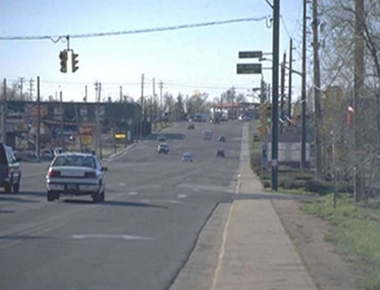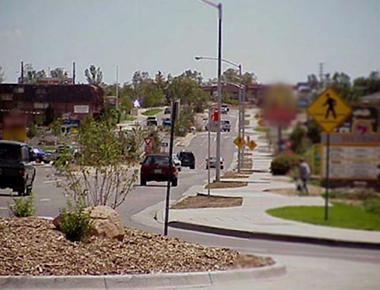Reducing Vehicle Speeds and Crash Severity through Self-Enforcing Roads in the City of Golden, CO
Speed Management | February 2022

Figure 1. South Golden Road Before the Improvement
Source: Colorado DOT

Figure 2. South Golden Road After the Improvement
Source: Colorado DOT
CHALLENGE
Communities continue to struggle with speeding related crashes and fatalities, and some are exploring “self-enforcing” roadways as a way to produce speed compliance that may contribute to less severe crash outcomes. The concept of self-enforcing roads is not new but has recently seen renewed interest with the adoption of the Safe System Approach. One community—the City of Golden, Colorado—embraced this concept more than 20 years ago and is still reaping the benefits.
In 1999, plans for a new shopping center along South Golden Road in the City of Golden, Colorado elevated citizens’ concerns about traffic speeds as well as pedestrian and bicycle safety along the corridor. South Golden Road was a wide (80 foot) street consisting of four through lanes plus a center turn lane. See Figure 1. The corridor was experiencing a number of issues including speeding between intersections, traffic conflicts at intersections for vehicles, pedestrians, and bicycles, and significant delays at certain intersections. The corridor experienced an average of four crashes per month with at least one of those involving an injury. The City initiated a study that included community input to identify the most viable alternatives for improvement.
ACTION
In response to the study, the City considered a range of improvement options and gained feedback from the community through public meetings, discussions with businesses, and at public hearings with the City Council. South Golden Road was rebuilt to be a self-enforcing road, a roadway that is planned and designed to encourage drivers to drive at operating speeds in harmony with the posted speed limit. The self-enforcing design replaced traffic signals with roundabouts, narrowed the road using center medians, restricted left turns, and addressed non-motorized users. See Figure 2.
RESULT
The City of Golden established corridor goals that resulted in reconstructing a wide, high-speed roadway that was experiencing safety and mobility issues. They chose to redesign the roadway to include roundabouts and medians. The new self-enforcing roadway design resulted in improved operations and safety and provided an aesthetically pleasing community space containing fountains, statues, landscaped medians, and community art. When the City examined the data in 2019, 20 years after construction, it found that the City had realized a significant reduction in speeds, a reduction in both crash frequency and severity even with increased traffic from the new shopping center, and improved pedestrian safety through reduced crossing times with few conflicts. The City also found that the new design positively impacted the adjacent business community in terms of fostering new development, redevelopment, and accommodating increased traffic volumes. These benefits are still being enjoyed today.
RESOURCES
Self-Enforcing Roadways Noteworthy Speed Management Practice
